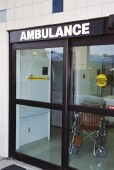
WEDNESDAY, May 23 (HealthDay News) — The number of regional care systems able to quickly identify, transfer if necessary, and treat patients experiencing the most severe form of heart attack is increasing, new research finds.
ST-segment elevation myocardial infarction, or STEMI, is a deadly form of heart attack that affects nearly 300,000 people in the United States per year. It occurs when a blood clot completely blocks an artery to the heart. Quickly restoring blood flow is needed in order to prevent death.
In a regional STEMI-care system, emergency medical services have the equipment on their ambulances to diagnose the heart attack on the way to the hospital, and hospitals cooperate to make sure that patients are delivered to a facility that can quickly activate a team able to treat the heart attack. That treatment is often the artery-opening procedure called percutaneous coronary intervention, commonly known as angioplasty.
Between April 2008 and January 2010, the American Heart Association conducted a survey of 381 regional STEMI-care systems that included nearly 900 hospitals in 47 states. Each system included at least one hospital that performs angioplasty, and one emergency medical service provider.
The survey found that 67 percent of the systems were in urban areas and most followed standard procedures and policies, such as:
- Admitting STEMI patients even when a hospital bed was not readily available (97 percent).
- Requiring a single phone call to activate the catheterization lab for angioplasty (92 percent).
- Permitting emergency department doctors to activate the catheterization lab without consulting a cardiologist (87 percent) and allowing the lab to be activated without a cardiology consultation before the patient arrives at the hospital (78 percent).
- Being part of a data collection registry (84 percent).
Competition among hospitals and cardiology groups was the most common barrier to implementing STEMI care systems. The researchers also found that about one-quarter of the systems have difficulties with emergency medical services’ transport and finances.
The study appears in the journal Circulation: Cardiovascular Quality and Outcomes.
“It’s essential to get competing hospitals and separate [emergency medical service] agencies within a community to work as a team to provide optimal care for heart attack patients,” lead author Dr. James Jollis, a professor of medicine at Duke University Medical Center, said in a news release from the American Heart Association.
More information
The U.S. National Heart, Lung, and Blood Institute has more about angioplasty.

